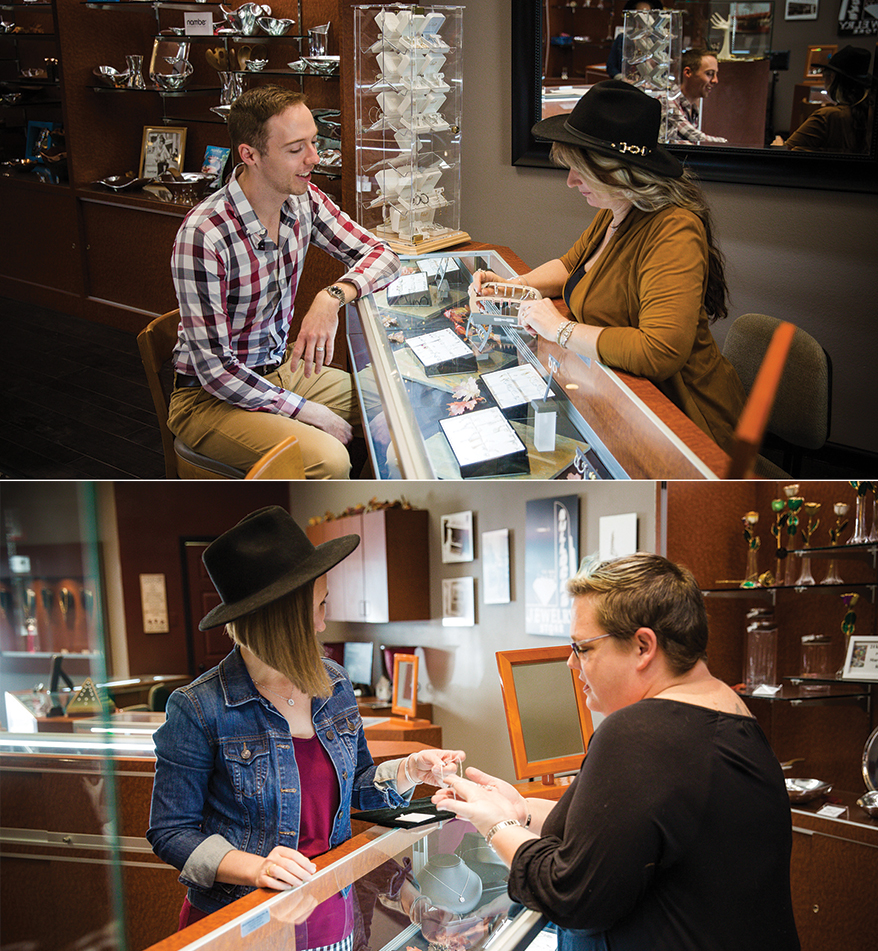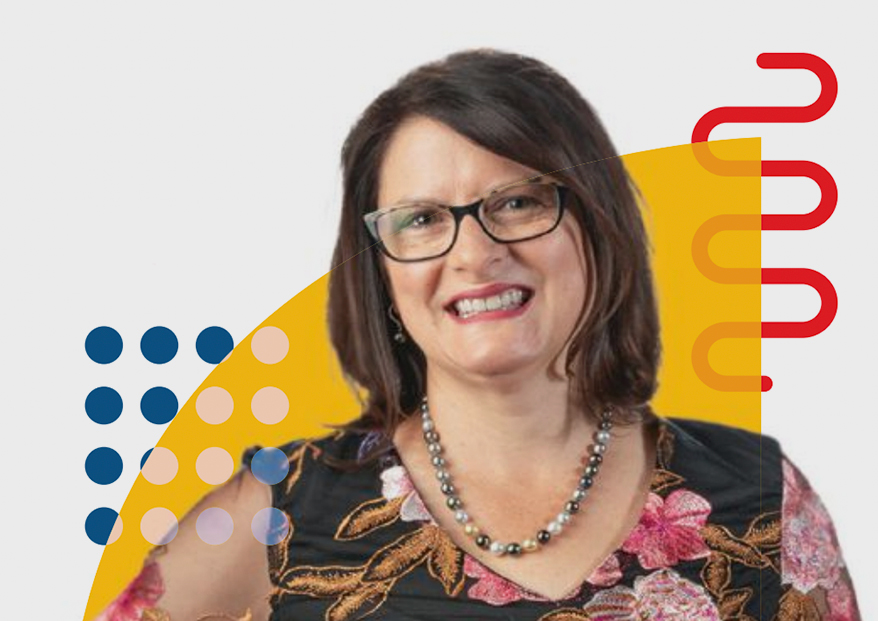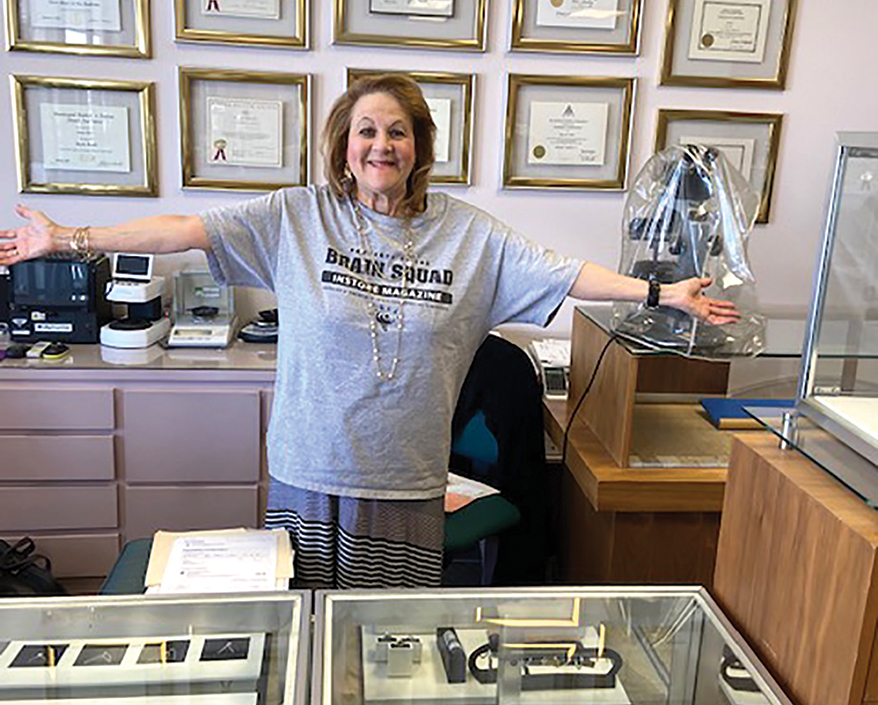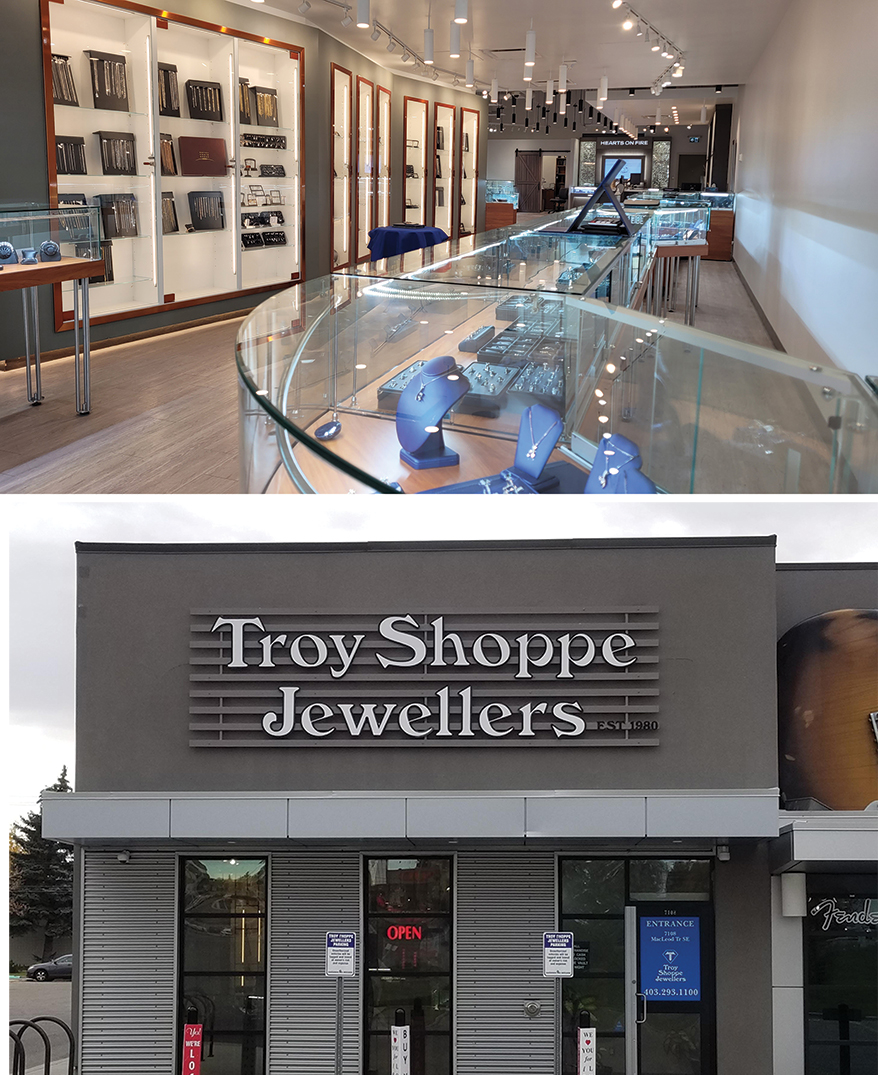TO SEE THE big picture, every company needs a strategic plan, a written roadmap for what it wants to accomplish over a defined period. A strategic plan provides details including goals, objectives and measures of success.
If that sounds like too much work, consider the rewards.
“My experience with clients is when we create a five-year plan, they often hit it in three or four years just because they MADE a plan,” says consultant Andrea Hill. “The five-year plan should be reviewed every year, but the strategy shouldn’t shift a lot.”
Jewelry industry consultant Mark Pimental says planning and strategy are not the same thing. Strategy is an integrative set of choices that places you on a playing field of your choice. It explains why you want to be on this playing field rather than another, and how you’re going to be better than anyone else.
“That’s the part people miss,” Pimental says. “Identifying where they fit. What is their niche? If you try to be everything to everybody, that is a big hill to climb.”
“They may look at revenue and KPIs, set those numbers, and believe that is their plan,” Pimental says. “However, strategy cannot be only about the numbers. Creating a strategic plan requires an understanding of the theory behind the numbers and making strategic choices.”
The key to having a strategic plan that works is knowing not only who you are and what makes you different but why that difference matters to potential clients, Hill says. “Why do we matter isn’t about ‘What makes me special?’ It’s ‘What is it about my customer that finds me special?’ That’s strategy in a nutshell.”
That means you need differentiation as well as competitive advantage.
Advertisement
“Being different from everyone else won’t matter if no one cares about your difference,” Hill says. “If I make pink post-it notes and everyone else makes yellow, that might make me different, but how do I make me different in a way that gives me competitive advantage?”
What makes you different goes beyond products. It’s your secret sauce. “It’s about how you sell and how you build customer relationships and loyalty. What do you teach people and how do you engage them?” says Hill.
Once the strategy is in place, it’s time for sales forecasting, marketing forecasting and operational strategy, which should be reviewed every year.
Hill often encounters resistance from small-business owners who believe strategy is for the big guys. She says she understands that when a business owner is in the weeds, it’s tough to find time to keep focusing on a strategy, or to keep asking, “Is this the strategic thing to do?”
“But they need to focus to not fritter away the resources they have. It’s not about what you’re saying yes to; it’s having the clarity to say no. Because every time you say yes to one thing, you say no to something else.”
It’s also vital to share your vision with your team to make sure everyone is aligned with the company goals and moving in the same direction. When you do, make sure it’s clear and simple.
When she creates strategies for businesses, she condenses it into one page and then creates a visual representation of it. “When your employees start to ask, ‘Is this strategic?’ you win!” Hill says. “That happens when your plan is clear and everyone knows what you’re trying to accomplish.”

Daniel Carvajal
STRATEGY BUILT ON IDENTITY
Liry’s Jewelry in Tampa, FL, has built an identity on the idea of offering high-quality jewelry at an affordable price. Daniel Carvajal, VP of Liry’s, has been loyal to the niche his grandmother and mother established for the company they founded. Fifty percent of the business is gold and silver chains, imported from Italy, with an emphasis on Miami Cuban chains, and marketing has been strongly focused on those products.
Carvajal has also focused on broadening the customer base through e-commerce, which now represents about half of the business. His next strategic shift is to begin a marketing campaign highlighting Liry’s bridal business to create a more diversified brand identity and a luxurious in-store experience. Through market research and customer preferences, the business identified engagement rings as a significant growth opportunity.
Liry’s strategy is to position itself as an expert in the engagement ring market through targeted digital marketing campaigns, social media strategies, and partnerships with influencers in the wedding and lifestyle space. By showcasing expertise, unique designs, and commitment to customer satisfaction, Liry’s aims to build a strong brand presence in the engagement ring market.
Liry’s advantage in this niche lies in its commitment to craftsmanship, customization, and a personalized shopping experience. The business invests in training its staff to become knowledgeable advisers for customers seeking the perfect engagement ring, ensuring they feel confident and supported throughout the process.

Bullock’s Jewelry makes all decisions based on three values: be honest, be relational, and be excellent.
CORE VALUES
Kyle Bullock, owner of Bullock’s Jewelry in Roswell, NM, worked for weeks with a business coach to come up with the three key values that form his strategy. Those core values are to be honest, be relational, and be excellent.
“Honesty is about integrity, our most valuable thing we carry in the store,” Bullock says. “Being relational is about prioritizing people and their stories over profit. Being excellent is all about exceeding expectations. With those ‘BE’ phrases, we can ask ourselves, ‘How can we take this customer/event/idea and make it EXCELLENT?’ or ‘How were we RELATIONAL with people above all else?’”
They filter all ads, product decisions, clienteling and more through those values.
“If a decision we are considering does not align with those values, then we don’t do it. This helps us stay focused on the things that are central to who we are and not lose ourselves as we work on growth,” Bullock says. “We find new and inventive ways to apply our values every day.”
Planning for an upcoming event is a prime example of how those values drive decision making. The staff proposed an in-store party with the goal of exceeding expectations (to be excellent). “They knew this was a value and already started with that in mind,” he says. “As a leader, I felt my job was to equip them to succeed and ask them how the event played into our values.” So, he asked how they could make the event not just about selling, but also about being relational.
Brainstorming produced a plan to ensure too many people wouldn’t show up at once, so the sales staff could focus on the people in front of them. “We created a sign-up list with appointment slots and divided the work on the day of, so that the sales team could stay with the appointment and I could run support for them,” Bullock says. Instead of just receiving a postcard, each client was personally invited.

Kyle Bullock
The result has been a lot of personal contact and grateful customers, who thanked them for the invitation even if they couldn’t attend. The contact paid off dividends in connecting with customers before the holidays.
The company’s values show up in their policies, too. The team has complete freedom to make the customer whole and happy within those values when it comes to warranty work, returns, exchanges and customer follow-up. They are expected to be honest, to not overpromise or “make stuff up,” to prize the customer relationship and to exceed expectations.
To ensure that every customer who makes a purchase receives a personalized gift and thank you from the associate who helped them, Bullock provides team members with company Visa cards. “The outcome is a team that gets to know people deeply and personally and establishes trust through honesty,” he says. “Customers tell us how much it means that we listened to them and made an experience they’ll never forget. For us, that’s how we win a client for life and what’s kept us going for almost a century.”

Dianna Rae High of Dianna Rae chose to focus on custom design to stand apart from other local jewelry retailers.
ROADMAP FOR GROWTH
Dianna Rae High and her husband, Jeff High, who created Gemvision CAD software for jewelry, own Dianna Rae Jewelry in Lafayette, LA. They knew from the time they moved into the market nine years ago that they would differentiate the business around custom design and technology.
The couple also developed a list of brand pillars to describe who they are.
“It’s been really helpful because every time we go to make a decision about partnering with someone or doing a certain kind of marketing, we go back to the brand pillars and ask, ‘Is this who we are?’ It helps to have that written down so you don’t go off track, try to be too many things to too many people, and water yourself down,” Dianna says.
Advertisement
Before putting their strategy into place, Dianna scoped out the competition.
“I went to every jewelry store in town and found there are a lot of good jewelers here,” she says. “We chose custom not only because that’s what we’ve always done, but it was something we could easily do to set ourselves apart. As more and more people get into custom, we continue to stay ahead of the game.
“We had to come up with other things when other people began using Matrix, to stay one step ahead of them. So, having our design workstations on the sales floor and having 3D printing are some of the things we do strategically to separate ourselves.”
Jeff also created a museum-quality display for a gem gallery in which loose colored gems are individually lighted. He also designed dynamic lighting to show gems and diamonds in a variety of lighting conditions: sunlight, daylight and evening.

Dianna Rae High
They also brainstorm creative marketing ideas. Working with NASA, Dianna Rae Jewelry became the first company to put diamonds on a mission to the International Space Station in 2022, a move that fit with their strategy of growing the business nationally without opening additional stores. Selling space diamonds led to nationwide publicity, boosting their SEO as well as their national sales. “We get inquiries every day now for virtual Zoom appointments,” Dianna says.
They’re growing in other ways, as well. A few years ago when renewing their lease, they requested first right of refusal for the space next door should it become available.
When their neighbors moved in 2023, they had 45 days to decide whether the time was right for an expansion that would double their size. “My husband and I are in our 50s, and thinking of expanding is not always a good idea unless you have a plan for the future,” she says. But when their daughter decided to join the business, that changed the equation, combined with the inescapable fact they’d outgrown their space and couldn’t hire another soul.
“Our staff was crowded in the back room, and on a busy Saturday, our customers were uncomfortable because it got crowded and loud in here. We were either going to stay stagnant or we were going to have to add space.” They decided to take the space. “For a custom boutique, it’s pretty big” at 2,600 square feet now, Dianna says.
The grand opening event in November came at the perfect time to celebrate their strategic growth. “I’m really happy a lot of people came in and were so happy to see we were growing,” Dianna says. “That showed customers we have potential and we’re a good place to shop. People like to work with successful people. Customers want to buy from positive people who are doing well.”
BEST QUALITY AT A FAIR PRICE
Beth Greene, manager of Conti Jewelers in Endwell, NY, found that developing a fully functioning e-commerce website fit the company’s goal of instilling a sense of trust. “It put us on the same playing field as bigger businesses and chain stores,” she says. “Having a fully functioning e-commerce website adds to your reputation and brand presence. That has had a significant impact on our growth.”
With a master’s degree in strategic marketing, she recognizes the power, too, of social media.
In 2020, when Greene joined the team, Conti had a nominal presence on Facebook and was beginning to explore Instagram; now the company is active on Pinterest and TikTok, reaching all age demographics. “Our 17-year-old intern posted a great TikTok,” says Greene, who set her up with proper lighting, keys to the jewelry cases and creative freedom. “She killed it. She blew it out of the water.”
In the past four years, store volume has doubled, the Conti team has doubled, and the size and number of events, in and out of the store, have doubled, too. “The best advice I can give to a store owner or manager when looking at big-picture projects or growth is to hire a team you trust with differing talents and delegate, delegate, delegate!”

Beth Greene
Conti’s big-picture strategy is to focus on customer service and provide the best quality jewelry at a fair retail price, something they always consider when deciding which new lines to bring in. They don’t put goods on sale or offer discounts.
“Without any doubt, our prices on staple lines are going to be significantly lower than other stores for that reason,” Greene says. “We want people to have high-quality luxury jewelry they will have in their family for a very long time. It’s an investment for them, and we want that investment to be worthwhile. We try to be really honest about what they’re investing in.”
Education, too, is strategic. Christopher Daniel, Conti’s owner and a bench jeweler, has gone the extra mile to educate and train his staff at his expense, says Greene, who is pursuing her graduate gemologist degree. Everyone on the team has completed the Applied Jewelry Professional course. “He is available to teach us at any time, and he encourages us to get as much education as possible.”
Greene finds that simply attending an IJO show or a seminar can renew everyone’s energy, and that returning from such a trip is the perfect time to review takeaways, strategies and goals. “It’s like a booster shot with a wave of ideas and goals.”
Advertisement
TOO MANY GOOD IDEAS?
Hill says that independent jewelers she knows have more ideas than they can use at any one time. “The fun for them is exploring ALL the ideas,” she says. “People don’t like making the hard choices and deferring the gratification of a new idea.”
Having a strategic plan helps prioritize those ideas. Extra ideas can be placed in an “idea piggybank” for future use.
Susan Eisen of Susan Eisen Fine Jewelry & Watches in El Paso, TX, concedes that her idea piggybank is overflowing, but she keeps them well organized in a database for the future. She worked with a consultant to help her focus and identify her main goals. “But that’s hard when you’re in retail. Someone quits, the computer breaks, customers are calling all the time.”
Eisen helps stay on track by taking notes on every seminar she attends, every publication she reads, and every consultant with whom she meets. She has 15,000 notes in a database categorized according to topic. “If I need to come up with advertising ideas, there they are.”
“I challenge myself to come up with two or three creative experience ideas for the next year. They can be crazy, they might not even be jewelry-related to make it unusual and different. Whenever I make a Plan A, I always have a Plan B, then I don’t feel so bad if Plan A doesn’t work. It’s not a failure; it’s OK that that didn’t work, now I’m doing this.”
As far as her business strategy, that’s almost a birthright. Eisen’s overarching goal is to be the best in the city no matter what it takes. “My father was a Marine, and I didn’t realize when I was young how much it was affecting me,” she says. “I want to know everything, have every credential, attend every show. That is my core value. The other thing is do the right thing.

Susan Eisen
“We constantly have to be thinking how we are different. Otherwise, you become diluted with everyone else.” One way she stands out is by becoming an author. Her first book, published in 2007, is CRAZY ABOUT JEWELRY! AN EXPERT GUIDE TO BUYING, SELLING AND CARING FOR YOUR JEWELRY.
“It gives you credibility,” she says. “It puts you in the realm of being academic and being authoritative about what you say. I’ve spoken a lot to groups about the subjects in the books. It did open a lot of doors.”
Big-picture planning extends to important purchases.
When she was in the market for a laser welder, the first thing she did was ask herself, “Is this right for me?” And the answer was yes, she says. “That’s because I believe in having the best repair center possible.” Eisen researched brands and consulted other research. More research went into figuring out how to pay for it. Once she made the plan, she didn’t look back. “You can’t let the what-ifs affect your strategic plan. Because you can talk yourself out of it.”
Self-imposed deadlines keep her on track. “When I wrote my first book, the only way I got through it was two chapters per week. Reward yourself or get mad at yourself, but at least you have the deadlines and they propel you forward. I don’t always meet them, but it’s a process that helps guide me through.”

David Blitt of Troy Shoppe Jewellers says making lists and trusting your staff are key to success.
SURVIVAL SKILLS
“Survival” is how David Blitt of Troy Shoppe Jewellers in Calgary, Alberta, Canada, describes one of his founding principles.
At age 24, he leased a space for $500 a month and acquired necessities like a cash register, boxes and inventory, one item at a time. Once he got on his feet, his goal was to excel at repair work, which really built the business. By 2000, he brought in Hearts on Fire and started focusing on custom bridal and high-quality diamonds while keeping focus on the repair business, too.
A history of resourcefulness came in handy when he was forced by his landlords to move in June 2023 to a shopping center, after spending 20 years in the same stand-alone location. Even in such an emergency, careful planning and delegation were vital, he says, to keep the business on track.
Blitt landed on his feet with a new location that has exponentially more car traffic than the previous one. The space has an open layout, up-to-date programmable LED lighting, and a big service counter, all of which enhance his service and repair strategy and make the store feel approachable.
He’s also landed two blocks from a major competitor, and the proximity has helped because when shoppers compare the merchandise and the experience, Troy Shoppe Jewellers often comes out ahead. “The first three days, we were here each day a person who came to their store then came to our store, and we made the sale right off the bat for $4,000, $5,000 and $7,000.”

David Blitt
They said that they were shocked that this competitor had wanted twice as much for the same look and size with lower-quality diamonds than what Blitt offered.
Blitt also hired a social media expert to bring a personal touch to the store’s marketing as he began to move away from radio advertising and highlight jewelry designs on Instagram. An educational blog has also found an ever-growing audience, by answering such questions as “Why do my small diamonds fall out?” and “Why is my ring not as white as when I bought it?”
He attributes his success with his unexpected move to a disciplined approach to strategic planning and the flexibility to anticipate and work around obstacles.
“It will suck lots of effort and time away from your daily store activities,” he says of a move. “You have to leave some issues for staff to handle and trust them. Write down various lists: things to do, things you need, people to talk to, quotes, and a schedule of what needs to be done by date. Getting it down and seeing it in writing makes you plan more and see the whole picture better. Then after all of that, be prepared to roll with mistakes and pay more money.”